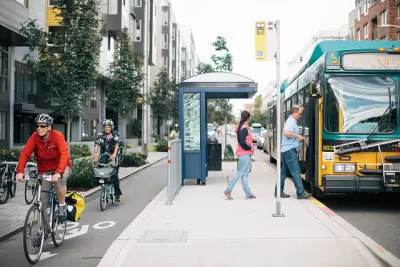As climate change brings prolonged, intense heat waves to cities once associated with rain and cold weather will have to attend to the lack of shelter provided to bus and transit riders.

Michelle Baruchman reports on the state of bus shelters in the city of Seattle, which has weathered a summer beset by record high temperatures—a sign of more heat waves to come as the planet's climate changes.
Baruchman cites data quantifying the city's bus shelters ("Of the approximately 7,500 Metro bus stops across King County, 1,700 have bus shelters…") before interviewing a question-and-answer session with researcher Kevin Lanza, who in 2019 published an article, along with Casey P. Durand, that explored the importance of bus shelters and trees for moderating heat.
In the interview, Lanza states that high temperatures are reducing transit ridership. In Lanza's words:
Trees have been shown to modestly reduce the effect of extreme heat on ridership or reduce the losses of ridership from extreme heat. Bus stop shelters don’t have that same association but both bus stop shelters and trees are proven heat management strategies that can in some specific instances be used exclusively or together to assist with climate adaptation of transportation networks.
While Los Angeles frequently makes news for transit shelter shenanigans, Seattle too passed up a chance to enter a public-private partnership to improve its shelters in 2018. The underfunding and mismanagement of bus and transit shelters is a nationwide problem, as detailed in an article from February 2020.
FULL STORY: How cities can help protect transit riders from extreme heat

Alabama: Trump Terminates Settlements for Black Communities Harmed By Raw Sewage
Trump deemed the landmark civil rights agreement “illegal DEI and environmental justice policy.”

Planetizen Federal Action Tracker
A weekly monitor of how Trump’s orders and actions are impacting planners and planning in America.

How Atlanta Built 7,000 Housing Units in 3 Years
The city’s comprehensive, neighborhood-focused housing strategy focuses on identifying properties and land that can be repurposed for housing and encouraging development in underserved neighborhoods.

In Both Crashes and Crime, Public Transportation is Far Safer than Driving
Contrary to popular assumptions, public transportation has far lower crash and crime rates than automobile travel. For safer communities, improve and encourage transit travel.

Report: Zoning Reforms Should Complement Nashville’s Ambitious Transit Plan
Without reform, restrictive zoning codes will limit the impact of the city’s planned transit expansion and could exclude some of the residents who depend on transit the most.

Judge Orders Release of Frozen IRA, IIJA Funding
The decision is a victory for environmental groups who charged that freezing funds for critical infrastructure and disaster response programs caused “real and irreparable harm” to communities.
Urban Design for Planners 1: Software Tools
This six-course series explores essential urban design concepts using open source software and equips planners with the tools they need to participate fully in the urban design process.
Planning for Universal Design
Learn the tools for implementing Universal Design in planning regulations.
Jessamine County Fiscal Court
Caltrans
Institute for Housing and Urban Development Studies (IHS)
City of Grandview
Harvard GSD Executive Education
Toledo-Lucas County Plan Commissions
Salt Lake City
NYU Wagner Graduate School of Public Service





























